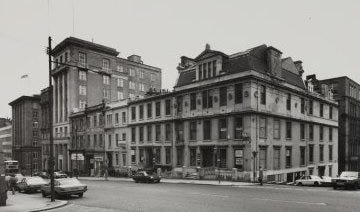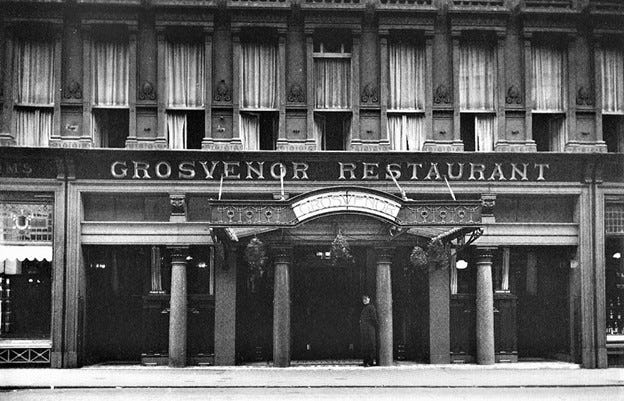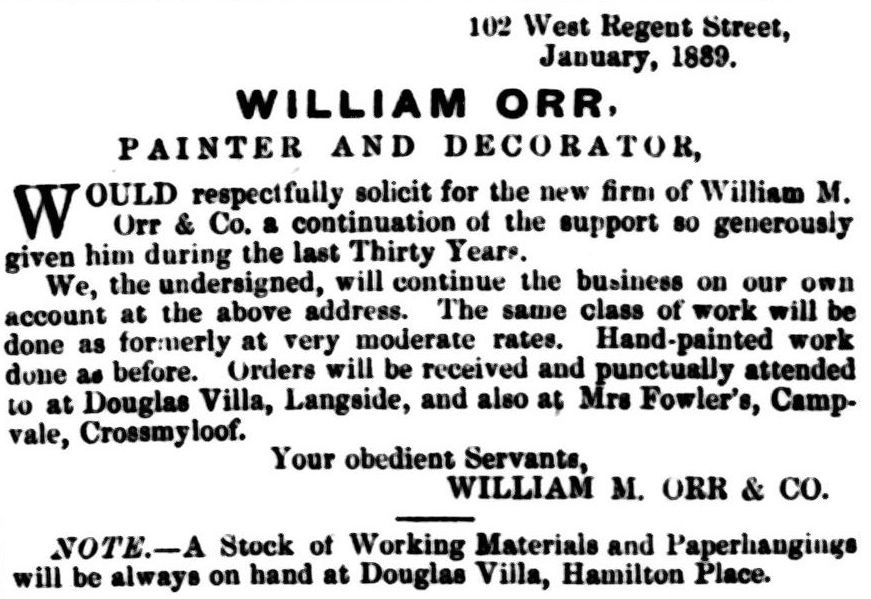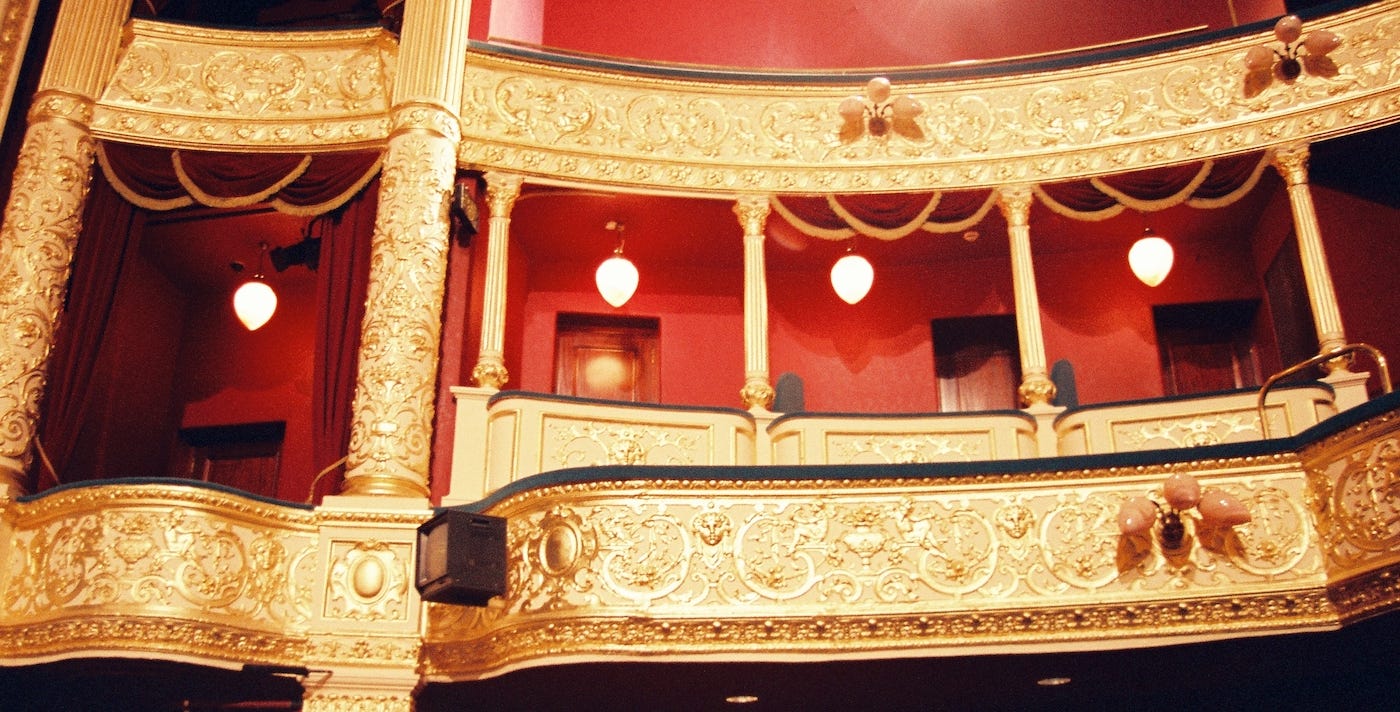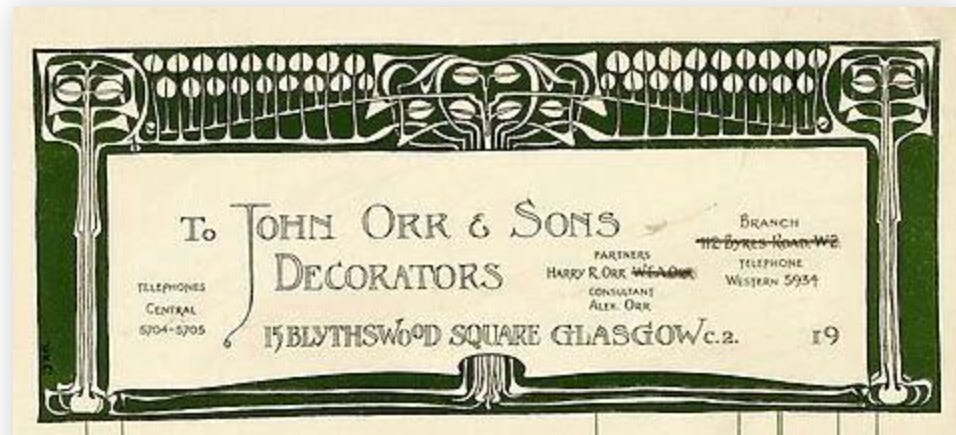The 'pernickitty' Brothers Orr
A generation of painters and decorators with something of an affinity for Thomson and his works
In 1872, Alexander Thomson wrote to his brother George in Africa on progress in decorating Robert Blackie’s new home at 7 Great Western Terrace:
‘We are now getting on with the painting of it with the Brothers Orr in the usual pernickitty way.’
At the time, three Orr brothers were active as painters and decorators. The firm was based at 173 St Vincent Street, but the brothers lived at various addresses on the south side of Glasgow: James in Crown Square, John in Apsley Place, and William in Hospital Street. There were two more brothers, Thomas, born around 1845 and who in 1861 was listed as an apprentice painter but who may have died or taken up another trade and Robert Armour, born in 1851.
These five brothers were the only known children of William Orr and Janet Foulds. Their father was from an Ayrshire family, born in Kilmarnock but who lived, married and raised his family in Dundonald; she was from Eaglesham in Renfrewshire. They married in 1837, and the sons were all born in Dundonald between 1837 and 1851.
William senior was twice listed in the Census as a molecatcher but was also a music teacher and leader of psalmody in the parish church. By 1853, he had become a grocer, but his house and shop burned down in late December that year1. The property was uninsured, and the following August, William senior committed suicide. Only four children are mentioned in the report2 of his suicide, suggesting the youngest, Robert Armour, had died before then. In 1861, Janet Orr was listed as a Housekeeper, accompanied by four sons living in a tenement at 54 Surrey Street in the Gorbals.
William Orr junior, the eldest son, first made his professional appearance as a painter and paperhanger in 1858, based at 60 Cumberland Street, Laurieston, advertising in the Christian News, a Glasgow-based evangelical publication (in 1865, he married ‘according to the forms of the Evangelical Union’ established in Kilmarnock just two days before the 1843 Disruption).
Orr Brothers
In June 1861, Orr Brothers first appeared in the Post Office Directory, although in later years, the partnership was given as established in 1859. If so, William would have been aged 22 and John Foulds Orr, the second brother, only 19. In the April 1861 Census, William and John described themselves as ‘Painters and decorators’.
By the middle of 1862, William and his wife had moved from Surrey Street to 192 Hospital Street, one of the two Thomson tenements erected some five years before at the rear of Caledonia Road Church. This may be where William Orr first encountered not just Thomson’s interior design but Thomson and his family, who had moved into Moray Place the year before and presumably now worshipped here rather than at the St Vincent Street congregation.

In 1861, John, the second brother, was still living at Surrey Street, but moved with his brother to Hospital Street (possibly with James as well). In late 1865, John married Catherine Ross, originally from Kilmartin in Argyll. They married at 58 Cumberland Street, where Catherine was living, next door to where the Orr brothers had their office, again according to the forms of the Evangelical Union. The following year John and his wife moved to 104 and then 147 Cumberland Street. John and Catherine’s marriage produced three children. At this time, the widowed Janet Foulds was living at 52 South Apsley Place; by 1869, John and family had moved to No. 32.
By the mid-1860s, the Orr brothers were doing well. They moved first from No. 60 to 41 Cumberland Street by mid-1866, advertising for more staff a year later. A year after that the firm advertised three addresses: 173 St Vincent Street, 138 Eglinton Street, and Ashton Place, Dowanhill. No. 173 St Vincent Street (below) was the basement of an end-terrace house converted to office use. (The larger online image here shows some curious pseudo-Greek detailing, but also that the building used typical Thomson railings). This remained the firm’s base for several years, unlike 138 Eglinton Street, which was only referred to for one year, a few doors south of the Hutchesontown Free Church (itself later converted into the Bedford Cinema) in a now-demolished block. Ashton Place was at what is now Nos. 174-204 Byres Road, occupied by Hillhead Underground station. In 1869, they were advertising from Byres Road for a ‘stout boy… of good character’ as an apprentice3.
The brothers also knew the value of paying a going rate for their workers. When a small group of master painters locked out their staff in response to a demand for a halfpenny increase an hour (to a minimum of 5 1/2d), Orr Brothers were among the much larger number of firms who paid up4.
In 1871, James, the youngest painter and decorator brother, gave his occupation as ‘Housepainter’, lodging at 198 Crown Street. He married five years later, in 1876, with both him and his wife giving 296 Crown Street as their address. They married at 277 Crown Street, but according to the forms of the United Presbyterian Church. He gave his occupation as ‘Journeyman Housepainter’, suggesting he was not playing any senior role in the Orr Brothers firm. His wife, Margaret Hill Yuill, gave her occupation as ‘Fancy Goods Merchant’s Clerk’.
While working on Great Western Terrace, John remained at 32 South Apsley Place, while William moved to No. 5 Regent Park Terrace, which had been completed by lte 1861, shortly after Thomson’s adjacent Moray Place5. By mid-1873, however, he had moved to 8 Roslyn Terrace on Nithsdale Road. It may have been about this time that Thomson prepared the design for the internal decoration (below), now in the Mitchell Library. Given William’s connections with Thomson, and especially since Thomson lived a few minutes’ away, it seems likely that the colour scheme would have been carried out, so may still exist under later decoration.
Ashton Place continued to be used as a company base, presumably while the brothers were working on Great Western Terrace, and by mid-1875, John and his family had moved there at No. 76.
After Thomson’s death, the Orr Brothers continued to be influenced by Thomson’s work. In late 1877, they redecorated the dining hall of the Govan Combination Poorhouse on the former Merryflats estate in Shieldhall. Designed by James Thomson and opened in 1872, it cost £100,000. It was erected by the two parishes of Govan and Gorbals, comprising a poorhouse, a 240-bed general hospital, and a lunatic asylum for 180 patients. At the time, it was hailed as ‘the finest asylum for the poor in Scotland’.
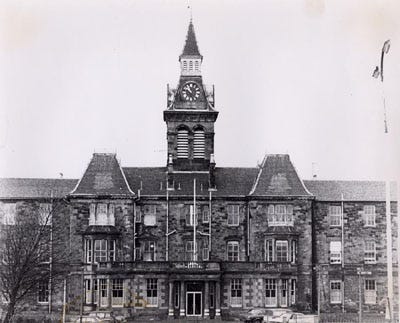
The description of the colour scheme, designed by the Orr Brothers, for a room 60 feet long by 40 feet wide and 25 feet in height is worth detailing:
‘Starting at the floor, we find the base, about 9 inches broad, as also the doors of the room, done in a rich dark moss oak, which in the case of the doors is relieved by black mouldings. Then, there is a surbase lining of wood, rising to a height of 5 feet, which is painted a very light oak. Immediately over this there is a 15-inch frieze of conventional Greek ornament, executed in a pale of yellowish brown which shades off above into a neutral green; and the walls for the most part afterwards are painted a neutral buff tint. We now come to the leading and special feature of Messrs Orr’s effort at decorating this interesting apartment. It is a frieze about three feet broad, which terminates above at the cornice, and commences below in a droop ornament executed in light brown, and seems intended to act as a sort of fringe. The frieze proper has a light straw colour ground, and upon this are painted the special elements of the frieze. First, there are representations of vases of two kinds, one of them being about 10 inches high, of pure or classic Greek, and containing a branch of French laurel liberally foliages, and the other not just so tall, also of Greek pattern (but perhaps too severe), and containing branches of honeysuckle in fruit. Simulating a sort of wire trelliswork, there are run round the room a series of four narrow parallel lines which serve to support the laurel and honeysuckle foliage, and on and amongst which there are distributed representations of some four or five hundred birds, or possibly more The colouring of the cornice is very effective, and as regards the ceiling… it is almost a facsimile of the ceiling of the City Hall, which was also done by Messrs Orr Brothers fully a twelvemonth ago…. In the north wall of the room there is a large recess, about two feet deep…. On each side of it there has been painted a medallion panel, four feet six inches in diameter, one of which represents “Morning,” and the other “Evening” - earth, sea and sky all being simulated with very great effect - the rising sun in the one case, and moon and stars in the other, and accompanied respectively by the lark and swallow, and the owlet and hawk. The efect of sea in the middle distance is obtained by the liberal use of silver leaf, with dashes of bright and sombre colours thrown in by hand’7.
Apart from this and the work at Great Western Terrace, not much is known of the Orr Brothers’ output: in 1871, they redecorated the Royal Restaurant at 8-10 West Nile Street and in 1876, the Montrose Street Evangelical Union Church, previously a United Presbyterian Church.
(In a later Thomson connection, in 1896, after one change of management, the Royal was taken over by William and John McKillop from Ayrshire, whose father was from Antrim. A decade before, the brothers had been members of the founding committee of Celtic Football Club. In 1899, they opened the Grosvenor Restaurant in Gordon Street (below). In 1900, William became MP for North Sligo and later for South Armagh.)
William and John were both involved professionally in the Glasgow Master Painters’ Association, with William acting as Secretary for some years: in 1879, he was presented with a timepiece ‘in recognition of his services to the club’8.
The brothers were also willing to demonstrate the properties of the materials they used: to promote Charlton white, a product of the Silicate Paint Company of Glasgow, Liverpool and London, they created a panel, half painted ‘with the best guaranteed brands of white lead, and the other half with Charlton white’, This was hung in Central Station, and ‘after two years’ exposure to some and atmospheric influences the white lead half has very sensibly darkened in colour, while the half painted with Charlton white has remained comparatively pure’.
The Silicate Paint Company was promoting its products at the Sanitary Congress in Glasgow in 1883; at the same event, J Orr & Co. of Wellington Street ‘fitted up a very pretty stand to show the uses to which Lincrusta Walton may be applied [for] staircases and the walls and roofs of dining rooms or drawing rooms... as an excellent substitute for wall paper’9.
J Orr & Co was John Orr, for the partnership with William had ended the year before, with William setting up on his own, based at 175 St Vincent Street (most likely an actual move next door rather than because of renumbering) with a branch at 9 Campvale, Crossmyloof. William regularly advertised for business, principally in the trade Glasgow Property Circular and West of Scotland Weekly Advertiser. By August 1887, following Queen Victoria’s Silver Jubilee, he was advertising himself as ‘Queen’s Gold Medalist’10, but the basis on which he did so is unclear.
However, William failed alone: in December 1888, he went bankrupt, with liabilities of just under £990. Apart from the money he had taken from the business, about £2,500 over five years, he admitted he had carried too much stock from the start, much of which had depreciated in value11. A sequestration sale followed12:
Within a month, Orr bounced back, based at 102 West Regent Street and trading as William M. Orr & Co., now living at Douglas Villa, Langside.
William M (‘Muir’) Orr was William’s eldest son, who presumably now took over the business but retained his father’s skills and contacts. Mrs Fowler was probably the widow of James Fowler, a stationer of 8 Campvale13, who may have kept a pattern book of wallpapers, etc., for potential customers.
William Muir Orr continued to advertise in the trade press, the last advertisement appearing in February 189114, but in the April 1891 Census, he is listed as a ‘Traveller’ (possibly representing his son’s business) living at 2 Calder Terrace, Cathcart. He died in July 1894 at 10 Albert Road, Langside.
After his father’s death, William Muir Orr may have continued the business for a while, but by the time he died in Glasgow in 1924, he was described as a ‘Journeyman painter’. None of William senior’s other seven children, three daughters and four sons, followed him in the trade. John Hannan Orr became a plumber and sanitary engineer, but later a master baker, Robert Watson Orr became an insurance agent’s inspector. Chalmers Orr worked as a clerk but died young in 1899. The youngest son, Charles Gardner Orr, first became a shoe salesman and emigrated to Winnipeg, Canada, in 1908, intending to work as a plumber.
James, the third Orr brother who is known to have worked professionally as a painter and decorator, continued to work in Glasgow until 1906 when he and his family moved to New York. In the 1910 Census, he described himself as an ‘Artist’ and died a year later. His only son, Arthur James, worked as a painter and decorator, dying in New York in 1940.
John Orr & Co.
This company’s output during the 1880s is little known: there are no reports of any decorating work, although John Orr spoke at the closing dinner for exhibitors at the 1883 Sanitary Congress. He may have changed trades: during this decade, a John Orr of Byres Road was involved in selling or leasing land and property in Vinicombe Street, Hillhead, as well as properties in Grosvenor Terrace and Victoria Terrace (there had been a legal dispute at the latter address between the Orr Brothers and another tradesman over tenements there in 1881). However, a John Orr, wright and builder of 10 Vinicombe Street, living at 5 Ruthven Street, was active in the 1890s, so this may be an error.
John Orr & Sons
By late 1891, John had taken two sons into partnership, James Muir and Alexander, aged 24 and 21, respectively, and later, the youngest son, Henry Ross, born in 1884. The firm’s work included painting, decorating, carving, picture-framing and gilding15. If he had worked as a joiner and dealt in property, it may have been while his sons were growing up and learning the trade. The firm’s earliest known work, perhaps undertaken to generate some awareness of their skill as much as for charitable purposes, was to decorate gratis the Girls’ Home at 302 St Vincent Street, under the aegis of the Glasgow United Evangelistic Association16.
They must have either been very cost-conscious or popular: in 1895, they were responsible for painting and papering the rebuilt Theatre Royal in Hope Street in a white and gold colour scheme, with the walls papered in a deep terra cotta red, with orange-yellow linings to the walls of the boxes (The colour scheme was probably broadly similar to that from the early 2000s shown below).
This was followed by the redecorated Glasgow Liberal Club in Buchanan Street at the end of 189617.
More importantly, John Orr & Sons feature regularly in the four job books of Honeyman & Keppie (later Honeyman, Keppie & Mackintosh), now held by The Hunterian at the University of Glasgow. Jobs for which they were paid include work at Anderson’s College Medical School in Dumbarton Road; Dunloe, Wemyss Bay; the Skin and Hide Market in Greendyke Street; additions and alterations to Craigie Hall, 6, Rowan Road; the Glasgow Herald buildings in Buchanan Street; St Paul’s Church mission hall and Beadle’s house at 16-22 Shuttle Street; and Ferndean, 5 Arthurlie Avenue, Barrhead.
Projects for which the firm tendered but was unsuccessful include the Canal Boatmen’s Institute at Port Dundas Road; work on Prestwick Free Church, Skelmorlie Parish Church, and additions and alterations to St Thomas Wesleyan Methodist Church in the Gallowgate; Honeyman & Keppie’s additions and alterations to Queen Margaret College hall of residence at Lilybank House (previously added to by Alexander Thomson) and the Glasgow School of Art.
That they were unsuccessful in some of their tenders does not seem to have harmed their relationship: Charles Rennie Mackintosh designed their invoice heading, which they continued to use at least up to 1947, updating addresses and other details as they went.
The firm also undertook the paintwork when Glasgow Central Station’s Argyle Street bridge was widened in 1904, and in the same decade, the nave of St John’s Roman Catholic Church, Port Glasgow, Kenmure United Free Church in Bishopbriggs, and Lansdowne Church Hall.
John became a JP and president of the Congregational Union of Scotland. He died at 24 Belmont Gardens, Glasgow, in 1921.
There were seven sons and three daughters from his marriage, but only some of John’s family entered into the business: William (1874-1922) became first a railway clerk, then trained as a Congregational clergyman, serving in Selkirk, St Petersburg (where he married the granddaughter of one of the founders of the Congregational church there) and at Airdrie, from which he retired in ill-health in 1916. He died at Ellerslie in Rothesay, one of a pair of semi-detached villas designed by Thomson originally for papermakers James and Robert Couper.
Ebenezer (b. 1875) served as a 2nd Lieutenant with the 6th Argyll & Sutherland Highlanders, then moved to South Africa where he worked as an accountant. He married, probably in South Africa, and died sometime after 1933.
Robert Watson Orr (1878-1915) became a cashier with the Standard Assurance Life Company, married and moved to London. A keen and successful amateur golfer, he became a 2nd Lieutenant in the London Regiment in the First World War and was killed at the Battle of Loos.
Another son, Frank George (1881-1945), trained as a cabinetmaker, then as a naval architect, but served in the First World War, becoming a Lieutenant-Colonel with the Royal Field Artillery. He ceased practising as an architect to work with the Council for Community Service, established in the 1930s to assist the unemployed. Married with four daughters, he later became managing director of a coal company and died in Ayr in 1945.
The painter and decorator sons
Three of John Orr’s sons did enter the business: James Morison Orr, Alexander and Henry Ross (‘Harry’) Orr, the eldest, second and youngest sons, respectively.
James Morison Orr
James Morison (1866-1926) worked first as a law clerk, then a cashier, before entering the family business. Living with his family at 1 Athole Gardens, Hillhead, he died at Garelochhead in 1926, having suffered from spinal sclerosis for some years.
James Morison’s eldest son, Ian Morison Orr, became a noted surgeon and medical missionary, working in India, where his three sons were born. The eldest of these joined the Army, with the second becoming a surgeon and being awarded the Polar Medal for work inthe Falklands Islands.
James Morison’s second son, James Robert Wallace Orr (1907-1992), won the Distinguished Flying Cross as a rear gunner in the RAF in the Second World War, having previously served in the London Fire Brigade during the Blitz. A painter, printmaker and teacher, he was a member of the staff at Glasgow Academy for many years until his retirement in 1967. He built a house to his own design at Moorgait, Kippen, where he lived from 1960. As an engraver, his work is represented in the City of London Guildhall Gallery, the City Hall, Aylesbury, in the Hunterian, Glasgow, the University of Stirling, and the Smith Art Gallery and Museum in Stirling.
James Morison’s only daughter, Kathleen Edith Gemmill Orr, married a Glasgow doctor, William Ernest Boyd (1891-1955), and her two sons also became doctors, the second, Ian Alexander (1927-1987), becoming an award-winning physiologist and professor at Glasgow University. Her husband worked as a radiologist and assistant physician at the Glasgow Homeopathic Hospital, while her elder son, Hamish William Boyd (1925-2014), was a consulting physician at the same institution and President of the Faculty of Homeopathy in 1979.
Alexander Orr
Unlike James Morison, Alexander (1870-1949) worked as a painter and decorator from his early 20s and probably remained involved in the business with his two brothers after his father died in 1921. Of his two sons, one, John ‘Jack’ Alexander (1898-1918), who lived at the ‘other’ Rosslyn Terrace in Kelvinside, died in the First World War as a Lieutenant in the Seaforth Highlanders. The second son, William Edward Anderson (1903-1967), joined the business in partnership with his uncle, Harry Ross Orr, after Alexander’s retirement.
The firm remained active through the 1940s: in 1942, as a precaution against fire, the Trades House of Glasgow asked John Orr & Sons to quote for ‘painting of rafters and supports of belfry with asbestos paint’. In March 1947, however, William Edward Anderson Orr retired from the partnership, and the business of John Orr & Sons was technically dissolved.
Harry Ross Orr
Henry ‘Harry’ Ross Orr (1884-1961), although the youngest and the only one of John Foulds Orr’s sons still connected to the firm, appeared to have no qualms about continuing the business under the same name as before, re-registering it as John Orr & Sons (Decorators) Ltd in April 194718. The Mackintosh invoice continued to be used, presumably until Alexander Orr’s death in 1949. The company continued to appear in business directories: from 13 Blythswood Square in 1950, even after Harry Ross Orr’s death (it is not known by whom), from 2 Clairmont Gardens in 1965, as ‘painters, decorators and art dealers’, and, according to the Post Office Directory, from 31 Dalmarnock Road, Rutherglen up to 1976.
Beyond that date, what happened to the company is unclear. An attempt to dissolve the company in March 2021 (possibly for non-filing of accounts) was voided, but John Orr & Sons (Decorators) Ltd was finally dissolved only in April 2023, 164 years after it was first established.
Confusingly, the Glasgow firm of Orr Decorators has operated since 1985, working on several high-profile projects, including the new Barclays site in Tradeston and the Burrell Renaissance Project. However, a call on the company indicates that they don’t believe there is any connection with the earlier firm.
The Blythswood Square connection
Back in 1860, when William Orr made his second appearance in the Glasgow Post Office Directory, as ‘Orr, William, house painter and paperhanger, 60 Cumberland street; house, 54 Surrey street’, Blythswood Square was somewhat awash with members of the Orr family: Sir Andrew Orr, ‘of Harvieston and Castle Campbell, and of F. Orr & Sons’ was at No. 5; James Orr, also of Francis Orr & Sons, was at No. 13, while John Orr, of R. F. and J. Alexander & Co.’, lived at No. 22. Francis Orr & Sons were ‘wholesale & export stationers and publishers’, based at 105 to 111 Union Street, the block on the western side at the junction with Gordon and Renfield Streets, and Francis was Sir Andrew’s father.
Francis Orr’s father, John, had been a printer in Saltmarket who dominated the trade in Gaelic publishing in Glasgow in the second half of the eighteenth century, with his wife continuing the business for some thirty years after her husband’s death. Francis’ son, Andrew, was Glasgow’s Lord Provost from 1854 to 1857 and knighted in 1858.
At No. 13 in 1860, James was Sir Andrew Orr’s younger brother. Sir Andrew purchased the Harviestoun and Castle Campbell estates in 1859 and extended the house on the former site (it was later de-roofed and then demolished in 1973). He died in 1872 (his wife and only daughter had died some twenty years before), and the estate passed to James, who may have then shared the Blythswood Square house with his sister, Elizabeth (Mrs David Bell). When she died there in 1891, she left almost all her money, some £70,000, to the Salvation Army.
James retained an interest in the property (No. 13 being the southernmost house on the eastern block) since his addresses in 1896 were given as ‘13 Blythswood Square, and Harviestoun Castle, Dollar’. James died in 1899, after which the house passed to a nephew, John Hutcheson Kerr, who died in 1904. By then, the property seems to have passed out of the Orr family’s hands. Coincidentally, that year, the architect James Miller was living at No. 15: twenty years later, he would incorporate No. 13 into the new headquarters for the Royal Scottish Automobile Club. The Mackintosh invoice heading gives No. 15 as the firm’s address: did they cohabit with Miller at some point? (In 1904, the year Honeyman & Keppie took Mackintosh into partnership, John Orr & Sons were officially based at 101/103 Wellington Street and 5 Ashton Place, Hillhead19).
Presumably, John Orr & Sons’ address at 13 Blythswood Square in the 1950s was entirely coincidental; rather than involving any distant family ties, it was being used as an accommodation address and linked, perhaps, to Harry Ross Orr’s membership of the RSAC (although using Club premises this way was against the rules). At the same time, it is interesting to note that Sir Andrew and his Orr family were, in fact, very distantly linked to Alexander Thomson through his wife, Jane Nicholson. However, neither family are likely to have been aware of the connection.
Information on the Orr family members can be found in the ‘Combination Tree’ on Ancestry.com
Glasgow Courier, 31 Dec 1853
Northern Daily Times, 26 Aug 1854
Glasgow Evening Citizen, 11 Sep 1869
Glasgow Sentinel, 1 Apr 1865
Glasgow Herald, 25 Oct 1861
By the 1960s, these were almost all single-storey shops; the upper-floor flats may have been taken down due to the construction of the Glasgow underground system in the 1890s.
Glasgow Herald, 17 Oct 1877
North British Daily Mail, 8 Feb 1879
Glasgow Herald, 24 Sep 1883
Glasgow Property Circular and West of Scotland Weekly Advertiser, 30 Aug 1887
Glasgow Evening Citizen, 15 Dec 1888
Glasgow Evening Citizen, 24 Jan 1889, and Glasgow Herald, 4 Feb 1889
Post Office Directory, 1882-3
Glasgow Property Circular and West of Scotland Weekly Advertiser, 17 Feb 1891
Text in this section is drawn from https://www.mackintosh-architecture.gla.ac.uk/catalogue/name/?nid=OrrJSon
Glasgow Herald, 3 Jul 1891
Glasgow Herald, 9 Sep 1895, Daily Record, 30 Dec 1896
The Scotsman, 13 Mar 1947
Post Office Directory, 1904-05




